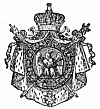
Every attempt has been made to replicate the original as printed. Some typographical errors have been corrected;a list follows the text. The Plates mentioned on page xv are not available to be includedin this etext at the present time. (etext transcriber's note) |
HISTORY
OF
J U L I U S C Æ S A R.

VOL. II.
THE WARS IN GAUL.
NEW YORK:
HARPER & BROTHERS, PUBLISHERS,
FRANKLIN SQUARE.
1866.
PUBLISHER’S NOTE.
IT is, perhaps, not without interest, in publishing the second volume ofthe History of Julius Cæsar, written by the Emperor Napoleon III., tocall to memory the names of Sovereigns and Princes who have employedthemselves upon the same subject.
The King of France, Charles VIII., showed an especial admiration forthe Commentaries of Cæsar, and the celebrated monk, Robert Gaguin,presented to him, in 1480, the translation he had made in French of theeight books of the War in Gaul. We are informed of this in the editionof the translation by the learned monk, printed in 1500. This edition,in large 4to, is from the press of Antoine Verard. (See J. Ch. Brunet,Manuel du Libraire et de l’Amateur de Livres, fourth edition, tom. I.,p. 518, and the Biographie Universelle, article Charles VIII.)
Charles V., who professed a great admiration for Cæsar, left a copy ofthe Commentaries filled with marginal notes, written with his ownhand. It was at his instigation that the Viceroy of Sicily, FerdinandGonzaga, sent a scientific mission into France to study Cæsar’scampaigns on the localities. The forty plans which were made by themembers of this commission, and among which that of Alise is found, werepublished in 1575, in the edition of James Strada.
The Sultan Soliman II., contemporary of Charles V., whom he had takenfor his model, sent through all Europe to procure as many copies ofCæsar’s Commentaries as could be found, which he ordered to becollated, and caused a translation to be made into the Turkish languagefor his own daily reading.
The King of France, Henri IV., translated the two first books ofCæsar’s Commentaries. The manuscript of this translation was depositedin the Bibliothèque du Roi, and M. des Noyers took it thence to deliverit to Louis XIII., who, in his turn, translated the two last books ofthe Commentaries. These two translations were joined together, andprinted at the Louvre in 1630.
Louis XIV. translated the first book of the Commentaries. Histranslation was printed at Paris in 1651, in folio, with figures. Thiswork has not been reprinted; it is now very rare. The reader may consulton this subject the Méthode d’étudier l’Histoire of the AbbéLenglet-Dufresnoy, tom. II., p. 481; and J. Ch. Brunet, Manuel duLibraire et de l’Amateur BU KİTABI OKUMAK İÇİN ÜYE OLUN VEYA GİRİŞ YAPIN!
Sitemize Üyelik ÜCRETSİZDİR!